Adapting to modern post-production workflows doesn’t just require new creative tools; reassigning resources can ensure cores used for rendering aren’t running idle or max out.
For decades, the renderfarm has been the backbone of visual effects and post-production pipelines.In major studios, this often meant entire rooms lined with high-performance computers, all designed for a single purpose: to process massive amounts of graphics data and keep projects moving forward.
But the demands placed on VFX pipelines have changed.Today, the challenge isn’t simply about brute-force rendering power – it’s about how efficiently that power can be used, how quickly it can be scaled, and how predictable delivery can become.A March 2025 survey from and Quantum, , underscored just how much pressure modern pipelines are under.
Respondents pointed to escalating costs and mounting technical complexity, with many citing the challenge of simply keeping infrastructure up to date as a bigger concern than meeting deadlines.Taken together, the findings highlight a core truth: while renderfarms still play a role, static infrastructure can’t keep pace with the speed, scale, and efficiency demands of today’s post-production environment.Why the old model is under strain Traditional renderfarms operate best when GPU and CPU workloads are perfectly balanced.
In practice, that balance is rarely achieved.GPU-heavy tasks often leave CPU cores sitting idle, while CPU-intensive processes can strand expensive GPUs in wait.The result? Idle capacity, unpredictable queues, and wasted spend on underutilized hardware.
This inefficiency becomes especially painful when delivery schedules are tight.Studios are expected to turn around increasingly complex work in shorter timeframes – all while budgets tighten and client expectations rise.In this environment, simply adding more hardware is no longer viable.
Splitting time and resources Enter GPU slicing.Unlike the traditional model where one physical GPU is tied to a single user or workload, slicing enables multiple users or processes to share the same GPU in an intelligent, dynamic way.Resources can be reassigned based on the demands of the render in progress, ensuring that no core sits idle while another maxes out.
That inefficiency adds cost at exactly the moment studios need to deliver more with less.Newer approaches like GPU and CPU slicing reallocate resources in real time, keeping every core active.Platforms such as Orion have shown that slicing can raise utilization rates dramatically – up to 92% for GPUs and 87% for CPUs, compared to industry averages of just 35–65%.
For VFX teams, that translates to less waste, shorter queues, and more predictable scheduling.By treating GPUs and CPUs as elastic resources instead of fixed assets, studios can minimize overprovisioning and increase throughput without adding more machines.Orchestration tools extend this principle further, reallocating GPU and CPU capacity not just within a single workstation, but across entire environments – from artist laptops to on-prem clusters and cloud instances.
At scale, this creates a unified pool of compute power where idle capacity is all but eliminated and render times become far more stable.Container-native workstations: portable, elastic, reproducible The other pillar of this new model is the rise of container-native workstations.Unlike traditional setups, these workstations package entire production environments – from operating systems to application stacks – inside containers.
The benefits are immediate: every artist works in a consistent environment, eliminating time lost to dependency conflicts or mismatched software versions.Resources can scale elastically, expanding to handle demanding shots or simulations and contracting again the moment the task is done.And with full portability, the same workstation can run seamlessly on a laptop, a local server, or in the cloud, ready to deploy wherever it’s needed most.
The result is a workstation model that feels like local performance but behaves like a flexible service.And unlike legacy VDI solutions, container-native approaches are built for modern workloads from the ground up, optimized for GPU and CPU-intensive applications.Beyond access: lowering the barrier for smaller studios Historically, only large studios with significant capital could afford racks of GPUs and CPUs – along with the cooling, power, and maintenance overhead required to keep them running.
Smaller firms and independent filmmakers were often shut out of producing visuals at the same fidelity.GPU slicing and container-native workstations change that equation.By maximizing utilization and enabling “pay for what you use” scalability, these technologies dramatically reduce the cost of high-performance rendering.
A boutique VFX house can now process large simulations or complex shots without owning a traditional renderfarm, while indie filmmakers can access professional-grade workflows without the same financial burden.This democratization of compute power is already reshaping the creative landscape.Ambitious visuals are no longer the exclusive domain of studios with deep pockets; they’re within reach for a much wider field of creators.
Lessons from other industries What’s happening in post-production mirrors trends across other high-performance computing verticals.In life sciences, researchers use GPU slicing to run multiple bioinformatics pipelines simultaneously.In defense and intelligence, container-native workstations enable secure, isolated environments that can scale without compromising compliance.
In every case, the drivers are the same: lower costs, predictable performance, and the flexibility to adapt infrastructure to shifting workloads.The VFX sector is unique in its creative demands, but it shares this need for elastic infrastructure that works at the speed of ideas.Adapting to a fast-paced industry The pressure on studios is clear: more deliverables, shorter deadlines, tighter budgets.
Legacy renderfarm models – while still useful in some contexts – increasingly act as bottlenecks.The future lies in infrastructure that is dynamic, intelligent, and cost-effective.GPU slicing and container-native workstations are not about replacing creative tools; they’re about removing technical barriers that slow creativity down.
They ensure that compute resources keep pace with the demands of modern pipelines, enabling faster iteration, more experimentation, and higher-quality output without runaway costs.Some studios are already adopting platforms like Orion to cut render queue times and boost resource utilization.By unifying on-prem and cloud resources under one control layer, these platforms provide the agility needed to scale without over-investing in hardware.
The new normal The renderfarm isn’t gone.It still has a place in the ecosystem, particularly for studios with steady, predictable workloads.But the era of relying solely on static racks of machines is over.
The industry is moving towards a new normal where resources are sliced, shared, and orchestrated across environments – and where container-native workstations give every artist a consistent, scalable platform to create.In this new model, infrastructure is no longer a constraint.It’s an enabler – one that levels the playing field for small studios, empowers large ones to deliver more with less, and helps the entire industry keep pace with accelerating creative demands.
The death of the renderfarm isn’t an ending.It’s a transition to something faster, smarter, and more accessible – the infrastructure that makes post-production work at the speed of imagination.// About Juno Innovations Juno Innovations is home to Orion, the platform that deploys high-performance virtual workstations across IT infrastructures.
Using container-native workstations and GPU/CPU slicing, Orion maximizes hardware utilization, accelerates rendering, and enables organizations to process high volumes of data with speed and efficiency.https://www.juno-innovations.com/ About Alex Hatfield Alex Hatfield is Co-founder and CEO of Juno Innovations.Previously working as a Camera Operator, Editor, and VFX Artist, Hatfield created Orion for the post-production community to adapt to modern, hybrid workflows.
He is now expanding the technology to serve other industries that manage complex, data-intensive workloads.Alex Hatfield is Co-founder and CEO of Juno Innovations, home to Orion, the platform that deploys high-performance virtual workstations across IT infrastructures.
Conductor Introduces Cloud-Based Rendering for Unreal Engine
AMD Radeon GPUs Turbocharge New AI Tools in CG Software
How Lenovo is Equipping M&E Professionals with the Right Tools for the Job in 2025
Smarter Tools from Lenovo with AMD Power Creatives in Media and Entertainment
Six Game-Changing New Features for Animators in the Latest Version of Unreal Engine









